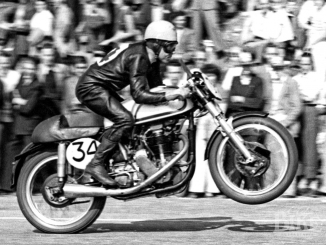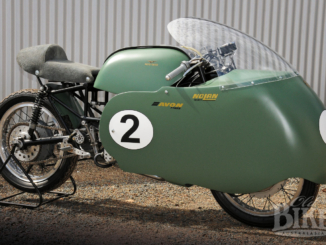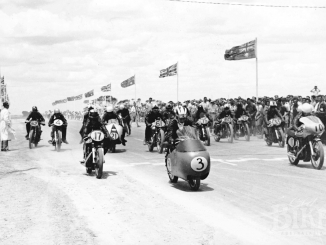
The big Guzzi single is as Italian as cappuccino, and one of the most sought-after big singles in the Classic world. It can be a bit tricky, identifying a real Falcone, because although the model was produced from 1950 to 1963, those that survive today have had their provenance somewhat diluted by restorers who have converted, at least cosmetically, the more plentiful ex-police and ex-military Turismo models into the far more desirable Falcone.
But we’re getting ahead of ourselves here, because any appraisal of the Falcone needs to start at the very beginning of Moto Guzzi itself, 90 years ago. The basic 500 cc design that would endure as the Falcone until 1963 started out as the 500 cc Normale (“Standard”), which itself was a toned-down production version of the delicious 4-valve bevel-driven single overhead camshaft prototype designed byCarlo Guzzi and financed by Giorgio Parodi. Referred to as the GP (for Guzzi-Parodi), the prototype was ‘productionised’ to the extent that the cast iron cylinder head on the horizontal single became 2-valve, exhaust-over-inlet design with the side inlet valve controlled by a coil spring while the exhaust valve used a hairpin spring. Quoted power output of the 88 x 82 mm bore and stroke engine was 8 hp with a weight of 278 lb (103 kg). Instead of the pressure-fed oiling system on the GP, the Normale used total-loss. The twin front downtube frame used a rigid rear end with un-damped girder front forks. The company name was also changed to Moto Guzzi as Parodi felt the GP appellation might be confused with his own initials.

For the initial production year, only 17 examples of the dark olive green Normale were produced. Quite separate from the bread-and-butter production machines, special racing versions beginning with the overhead valve C2V and later the 4-valve C4V were built and were highly successful in record breaking and road racing. The C2V was actually produced to special order and were popular with the privateers who could afford them. The next two decades were a time of constant evolution for the Normale, which quickly became the Sport. The Sport was offered with lights as an extra, and a front brake as standard, while engine tweaks pushed the power up to 13 hp at 3,800 rpm. In 1928, the Sport was joined by the Grand Tourismo (GT) which boasted a frame with swinging arm rear suspension, the springing controlled by rods operating springs in a box beneath the engine unit. The sprung frame concept was, however, slow to catch on with the buying public, although when the racing C4V began to achieve success with this design, sales of the GT picked up.
1928 also saw the up-rated Sport 14 introduced, still with the rigid frame but offered with magneto ignition and a Miller dynamo. A road-going production version of the C2V racer, the 2VT, came on stream in 1930, offering the extra performance of the OHV engine and restyling that included a modern saddle-style fuel tank. This became the GT 2VT in 1934, using the sprung frame. Meanwhile, the mainstay model, still using the venerable exhaust-over-inlet valve arrangement, became the Sport 15 in 1931 and endured until 1939 as the biggest selling model in the range.
The mid 1930s saw Moto Guzzi branch out into the construction of a model specifically designed for military use; the GT 17. Various configurations were available, including those with armament mounts. The GT 17 also found favour with police departments in Europe. Meanwhile, the production 500 was extensively redesigned for 1934 to become the 500V, using overhead valves with hairpin springs, a four-speed gearbox and with power up to 18 hp at 4,300 rpm. The girder front forks gained friction dampers, while both rigid and sprung famed (GTV) versions were offered. Still reluctant to completely abandoned the e-o-I design, the original style engine was available as the no-frills 500S and the sprung frame GTS. It was sound business sense, as the workhorse model easily outsold the sportier versions.
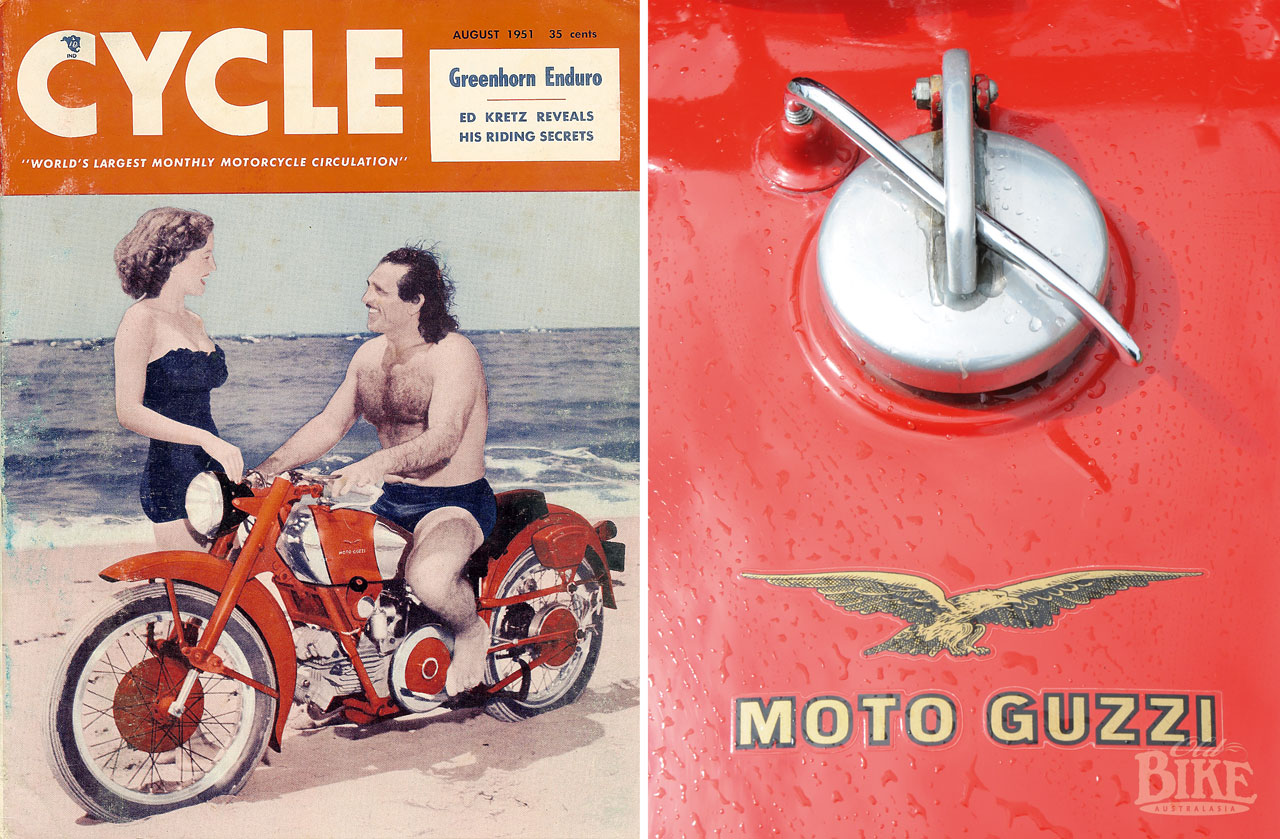
From the rather bewildering array of 500 cc models available prior to Italy’s intervention in WW2 in 1940, just two, the GTV and the GTW were built when post-war production recommenced at Mandello del Lario. The former morphed into the Astore in 1950, while the sportier GTW became the Falcone soon after. By now, production of the 500s was slow compared to the lightweight models in the range, with only a few hundred Falcones produced each year. Closely styled on the beautiful racing Dondalino (literally meaning ‘Sway’ but reputedly named because the machine had a tendency to weave at top speed in a straight line), the new Falcone featured Guzzi’s own ‘upside down’ telescopic front forks, while at the rear the unloved hydraulic dampers gave way to friction damping for the swinging arm. Alloy Borrani rims, as fitted to the pre-war racing Condor added to the sporting touch, but the biggest news was in the completely redesigned engine. Finally, the valve gear was enclosed, with lightened flywheels and con rod. Breathing through a racing-type Dell’Orto SS 29A carburettor, the new engine made 23 hp at 4,500 rpm. Many of the Dondolino’s trick engine bits – higher compression piston, higher-lift cams and a larger carburettor – could be easily fitted to the Falcone to produce a very spirited mount. Weight had been trimmed to 176 kg and top speed pushed slightly to 135 km/h. By 1953 the Airone had become the sedate version of what was now called the Falcone Sport, called the Falcone Turismo and producing a leisurely 19 hp.
Detail changes were made for the next decade, although production remained modest; 1960 being the peak of production with around 1,150 Falcones produced. The end of the Falcone officially came in late 1963, but there were still military and police markets to supply, and in 1967 the model was re-launched, at least in name as the Nuovo Turismo, using the Falcone Sport engine, still with the 280 mm external flywheel and fitted with windshield and legshields. Less than 1,000 were produced prior to the end of 1968. But still demand persisted from official quarters, and the result was the Nuovo Falcone with the basic engine tidied up and with the trademark outside flywheel enclosed, in a completely new and more modern chassis. This engine featured wet sump lubrication for the first time, a 12-volt coil-ignition electrical system and an optional extra electric starter. All these refinements added considerably to the bulk with the result that the Nuovo Falcone tipped the scales at 214 kg. In this form it continued until 1976 but for the Moto Guzzi purists, the real Falcone died in the European winter of 1963 after an amazing existence dating back 42 years.
A much travelled Falcone
Garry Pratt has a soft spot for Moto Guzzis. There are several of the big twins in his garage, plus the 1951 Falcone Sport featured here. Of course, it looked nothing like this when Garry acquired it in 1992, after following up an advertisement in what was then the swap-shop for vintage and classic bikes, the Sydney Trading Post weekly paper. Garry’s Falcone rolled out of the Mandello del Lario factory on 7th July, 1951 – 30 years after the marque was established. It was an export model and was soon on its way to its new owner in Uruguay – one Ms Mariesa of Montevideo. 41 years later it was back on the water, this time en route to Sydney as part of a consignment of several motorcycles plus the worldly possessions of Enrique Ferreira, a furniture manufacturer who had oreviously emigrated to Australia and had established a furniture manufacturing business in Revesby, Sydney. For the voyage, the Falcone had numerus old British bikes for company, but the group was split up almost immediately upon arrival and Garry Pratt took possession on 3rd August, 1992.

“It was in pretty poor shape,” says Garry. “ Somebody in Ureguay must have owned a chroming factory, because there were lots of things chromed that shouldn’t have been chromed. The timing chest was chromed onto the alloy as were lots of other parts like the frame bolts that I had to have stripped.” Although mostly standard, there were aberrations like the handlebars, seat, mudguards, muffler and lights that needed replacing with original components. “Although this is a 1951 model, I have finished it in 1952 colours because originally the 1951 petrol tank had chromed sections and the tank that came with this bike wouldn’t stand rechroming. The oil tank also has a chrome section in it. I have since found another tank that I am going to have chromed to take it to the correct colours for the year.”
“From the factory they didn’t actually have a speedo but you could fit either a Veglia or a Smiths. The tricky part is that because the speedo drive runs off the front wheel it runs the opposite way to the usual style from the rear wheel, and it’s also a different ratio.” Garry, a fitter and machinist by trade, did the entire restoration himself, with the exception of the chrome plating. He has a home zinc plating kit that he says gives excellent results with the right preparation, and the result certainly shows. One tricky job was to find the correct float bowl. Because the carburettor sits level, it needs a parallel flange for the bottom bowl mount. Most Dell’Orto bowls, such as those fitted to Ducati singles, are angled at around 15º to compensate for the downdraught angle of the carburettor. “ I had to use an after-market piston, which is not as good quality as the original Mondial. I fitted rings from a Daihatsu Charade which went straight in. There’s every size nut, bolt and shaft you can think of; 5,6,7,8,9,10,11 mm, even the rear brake rod is 7 mm, and the one that came with the bike wasn’t correct, so when I went to make a new one I couldn’t get 7mm material, so I had to turn down 8 mm.”
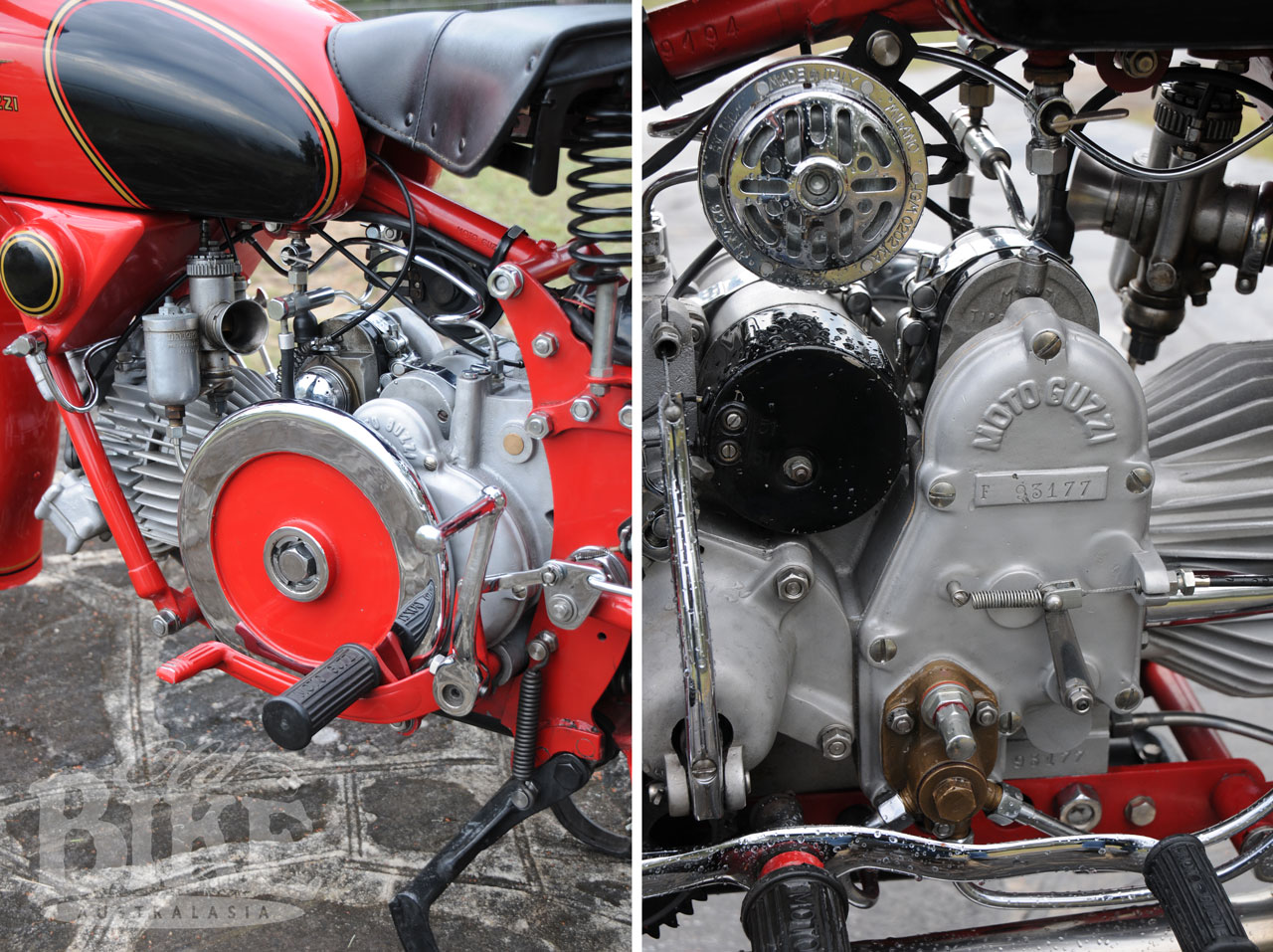
“This bike gets used a lot,” says Garry. “I take it to the Ragged Fringe Rally most years, and I load it up. I’ve done well over 50,000 kilometres. Some days on our runs I do 5 or 600 km a day. Five years after I restored it, it started playing up, but it was irregular, sometimes when it was cold and other times when it was hot. Anyway it turned out to be the bakelite cap containing the pick up brush for the magneto slip ring, it must have had a hairline crack because it took ages to find the actual fault. That’s the only problem it has ever had. It’s great to ride, will cruise all day, and on the dirt roads it is brilliant.”
“The forks are oil damped with the dampening unit contained in the lower inner fork leg and the dampening rod attached to the top of the outer fork leg. The forks have an adjustment system in a box on each leg. In one side (of the box) there’s a sort of half block, and the other side has a v-shaped roller, and they’re both mounted on little cams – the shafts are slightly offset so to adjust the clearance you loosen the bolts off and turn them in or out to take up any wear. The rear suspension is fully triangulated. You can still get the original Lafranchini mufflers. Every now and then they do a run and stamp them out. There are some other copies but they are not as well made.”
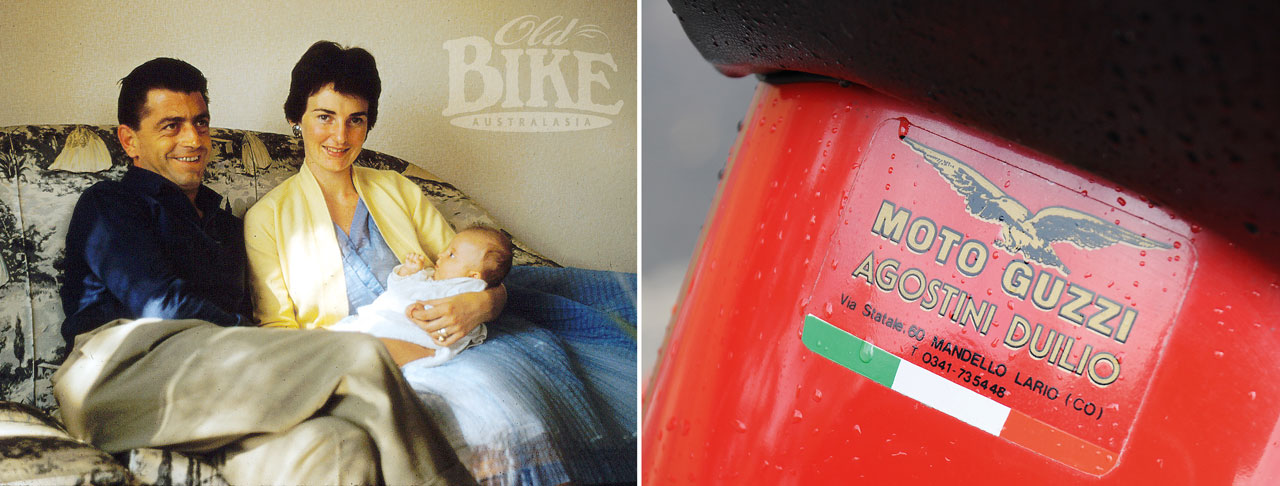
The Falcone (and other Guzzis of the period) have a curious Australian connection that began in 1956. The Moto Guzzi dealership in the factory’s home town of Mandello del Lario was started by Duilio Agostini (no relation to Giacomo). Duilio’s family owned the Hotel Giardinetto, overlooking Lake Como, which was a favourite home away from home for Moto Guzzi factory riders like Stanley Woods, Omobono Tenni and many others, together with the management of Moto Guzzi itself. After studying at the Moto Guzzi Mechanical Design Facility, Duilio found employment at the factory in 1947 and became a test rider working alongside the legendary engineer Guilio Carcano, who designed the v-twin Gambalunga (“Long-legged”) and the fabulous V8. In 1953 Duilio won the prestigious Milano-Taranto race and took out the Italian Championship, earning himself a place in the works team the following year alongside Ken Kavanagh and Fergus Anderson. In 1955, the year the Moto Guzzi team took a clean sweep of Grands Prix in the 350 cc World Championship, Duilio won the French Grand Prix and took 8th place in the Isle of Man Junior TT. While in the Isle of Man, he met Margo, an Australian lady whom he married in 1956. After opening a workshop specialising in Moto Guzzi the same year, Duilio became the official concessionaire for the marque in 1957. It was a real family business, with both his daughters, Alis and Lindy, working at the dealership. Duilio passed away in 2008 and Alis sold the business soon after.
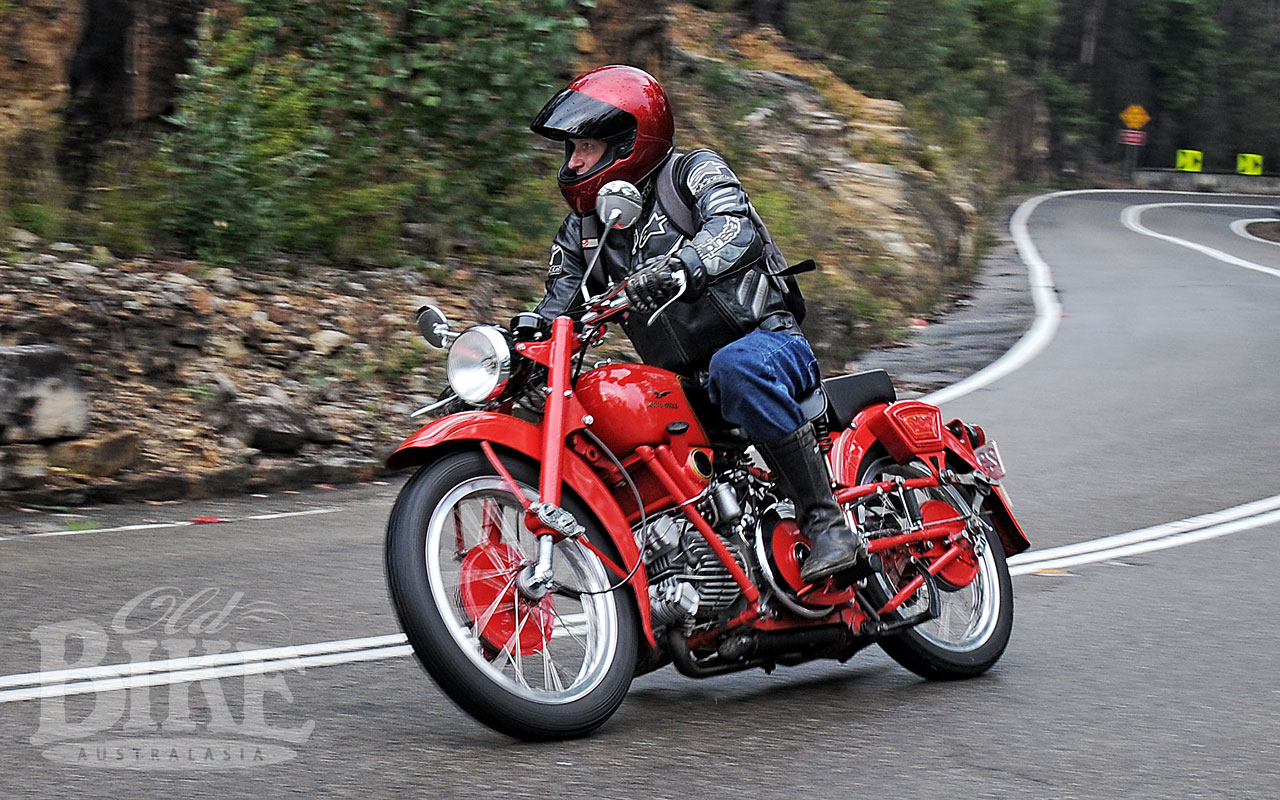
“Alis Agostini was a fantastic help in the restoration”, says Garry, “In fact if it wasn’t for her it probably wouldn’t have been possible. This was before the days of emails and I would just ring her or write to her and the parts would arrive, with no pre-payment or anything.”
During the restoration, Garry spent a lot of time checking the similar bike owned by Peter Bradley. “I used to go down to Peter’s place and measure parts – things like the back brake adjuster that was missing,” says Garry. “Peter was one of the founders of CIMA – the Classic Italian Motorcycle Association, but when his wife passed away from cancer he decided to do a bit of travelling and went to Italy, intending to stay for a year. He learned to speak Italian and naturally made contact with Alis Agostini. Ten years later, Peter is still there, and he and Alis are now a happy item. I met Alis when she and Peter came out to Australia for Christmas a few years back.”
Garry’s Falcone Sport has travelled a long way from its birthplace in the incredibly picturesque Mandello del Lario in Lombady on the shores of Lake Como, and its travelling days are not over yet, thanks to Garry Pratt’s dedication to restoring the old girl and his love for giving her a gallop at every opportunity.
Specifications: Moto Guzzi Falcone Sport 1951.
Engine: Horizontal OHV single
Bore x stroke: 88 mm x 82 mm.
Compression ratio: 6.5:1
Power: 23 hp @ 4,500 rpm
Ignition: Magneti Marelli magneto
Carburettor: Dell’Orto SS 29A
Gearbox: 4-speed
Wheelbase: 1500 mm
Weight: 167 kg
Max speed: 135 km/h
Fuel tank capacity: 17.5 litres
Oil capacity: 3 litres
Story: Jim Scaysbrook • Photos: Garry Pratt, Keith Bryen and Jim Scaysbrook


